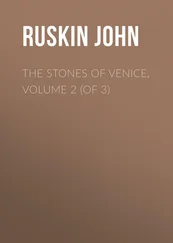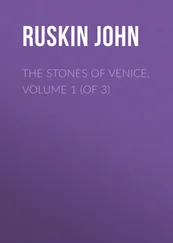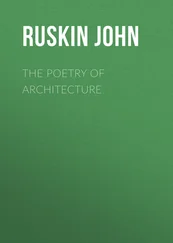§ VII. The mathematician knows there are many kinds of angles; but the one we have principally to deal with now, is that which the reader may very easily conceive as the corner of a square house, or square anything. It is of course the one of most frequent occurrence; and its treatment, once understood, may, with slight modification, be referred to other corners, sharper or blunter, or with curved sides.
§ VIII. Evidently the first and roughest idea which would occur to any one who found a corner troublesome, would be to cut it off. This is a very summary and tyrannical proceeding, somewhat barbarous, yet advisable if nothing else can be done: an amputated corner is said to be chamfered. It can, however, evidently be cut off in three ways: 1. with a concave cut, a ; 2. with a straight cut, b ; 3. with a convex cut, c , Fig. LII.
Fig. LII.
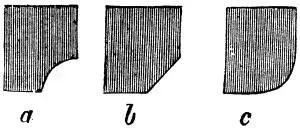
The first two methods, the most violent and summary, have the apparent disadvantage that we get by them—two corners instead of one; much milder corners, however, and with a different light and shade between them; so that both methods are often very expedient. You may see the straight chamfer ( b ) on most lamp posts, and pillars at railway stations, it being the easiest to cut: the concave chamfer requires more care, and occurs generally in well-finished but simple architecture—very beautifully in the small arches of the Broletto of Como, Plate V.; and the straight chamfer in architecture of every kind, very constantly in Norman cornices and arches, as in Fig. 2, Plate IV., at Sens.
§ IX. The third, or convex chamfer, as it is the gentlest mode of treatment, so (as in medicine and morals) it is very generally the best. For while the two other methods produce two corners instead of one, this gentle chamfer does verily get rid of the corner altogether, and substitutes a soft curve in its place.
Fig. LIII.
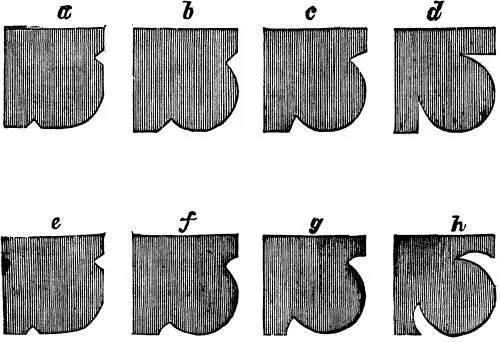
But it has, in the form above given, this grave disadvantage, that it looks as if the corner had been rubbed or worn off, blunted by time and weather, and in want of sharpening again. A great deal often depends, and in such a case as this, everything depends, on the Voluntariness of the ornament. The work of time is beautiful on surfaces, but not on edges intended to be sharp. Even if we needed them blunt, we should not like them blunt on compulsion; so, to show that the bluntness is our own ordaining, we will put a slight incised line to mark off the rounding, and show that it goes no farther than we choose. We shall thus have the section a , Fig. LIII.; and this mode of turning an angle is one of the very best ever invented. By enlarging and deepening the incision, we get in succession the forms b , c , d ; and by describing a small equal arc on each of the sloping lines of these figures, we get e , f , g , h .
§ X. I do not know whether these mouldings are called by architects chamfers or beads; but I think bead a bad word for a continuous moulding, and the proper sense of the word chamfer is fixed by Spenser as descriptive not merely of truncation, but of trench or furrow:—
“Tho gin you, fond flies, the cold to scorn,
And, crowing in pipes made of green corn,
You thinken to be lords of the year;
But eft when ye count you freed from fear,
Comes the breme winter with chamfred brows,
Full of wrinkles and frosty furrows.”
So I shall call the above mouldings beaded chamfers, when there is any chance of confusion with the plain chamfer, a , or b , of Fig. LII.: and when there is no such chance, I shall use the word chamfer only.
§ XI. Of those above given, b is the constant chamfer of Venice, and a of Verona: a being the grandest and best, and having a peculiar precision and quaintness of effect about it. I found it twice in Venice, used on the sharp angle, as at a and b , Fig. LIV., a being from the angle of a house on the Rio San Zulian, and b from the windows of the church of San Stefano.
Fig. LIV.
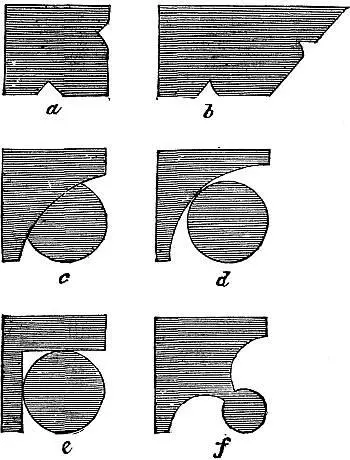
§ XII. There is, however, evidently another variety of the chamfers, f and g , Fig. LIII., formed by an unbroken curve instead of two curves, as c , Fig. LIV.; and when this, or the chamfer d , Fig. LIII., is large, it is impossible to say whether they have been devised from the incised angle, or from small shafts set in a nook, as at e , Fig. LIV., or in the hollow of the curved chamfer, as d , Fig. LIV.In general, however, the shallow chamfers, a , b , e , and f , Fig. LIII., are peculiar to southern work; and may be assumed to have been derived from the incised angle, while the deep chamfers, c , d , g , h , are characteristic of northern work, and may be partly derived or imitated from the angle shaft; while, with the usual extravagance of the northern architects, they are cut deeper and deeper until we arrive at the condition f , Fig. LIV., which is the favorite chamfer at Bourges and Bayeux, and in other good French work.
I have placed in the Appendix 73a figure belonging to this subject, but which cannot interest the general reader, showing the number of possible chamfers with a roll moulding of given size.
§ XIII. If we take the plain chamfer, b , of Fig. LII., on a large scale, as at a , Fig. LV., and bead both its edges, cutting away the parts there shaded, we shall have a form much used in richly decorated Gothic, both in England and Italy. It might be more simply described as the chamfer a of Fig. LII., with an incision on each edge; but the part here shaded is often worked into ornamental forms, not being entirely cut away.
Fig. LV.

§ XIV. Many other mouldings, which at first sight appear very elaborate, are nothing more than a chamfer, with a series of small echoes of it on each side, dying away with a ripple on the surface of the wall, as in b , Fig. LV., from Coutances (observe, here the white part is the solid stone, the shade is cut away).
Chamfers of this kind are used on a small scale and in delicate work: the coarse chamfers are found on all scales: f and g , Fig. LIII., in Venice, form the great angles of almost every Gothic palace; the roll being a foot or a foot and a half round, and treated as a shaft, with a capital and fresh base at every story, while the stones of which it is composed form alternate quoins in the brickwork beyond the chamfer curve. I need hardly say how much nobler this arrangement is than a common quoined angle; it gives a finish to the aspect of the whole pile attainable in no other way. And thus much may serve concerning angle decoration by chamfer.
73Appendix 23: “Varieties of Chamfer.”
CHAPTER XXIII.
THE EDGE AND FILLET.
Table of Contents
§ I. The decoration of the angle by various forms of chamfer and bead, as above described, is the quietest method we can employ; too quiet, when great energy is to be given to the moulding, and impossible, when, instead of a bold angle, we have to deal with a small projecting edge, like c in Fig. LI.In such cases we may employ a decoration, far ruder and easier in its simplest conditions than the bead, far more effective when not used in too great profusion; and of which the complete developments are the source of mouldings at once the most picturesque and most serviceable which the Gothic builders invented.
Читать дальше










